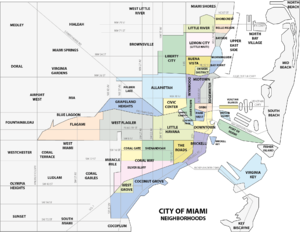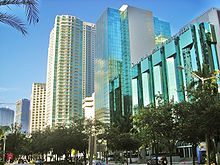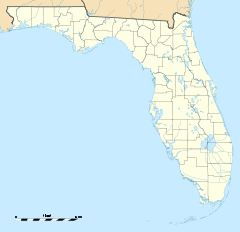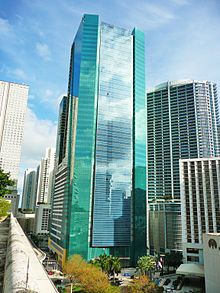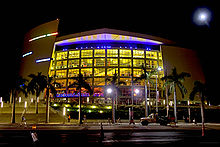- Downtown Miami
-
Downtown Miami — Neighborhood of Miami — Downtown Miami skyline as seen from Biscayne Bay to the east Nickname(s): Downtown, Central Business District Downtown neighborhoods within the City of Miami Coordinates: 25°46′27″N 80°11′25″W / 25.77423°N 80.190368°W Country United States State Florida County Miami-Dade County City Miami Settled 1830s Incorporated into the City of Miami 1896 Subdistricts of Downtown Neighborhoods list- Brickell
- Central Business District (CBD)
- Downtown Miami Historic District
- Jewelry District
- Omni
- Park West
Government – City of Miami Commissioner Marc Sarnoff – Miami-Dade Commissioners Carlos A. Giménez, Bruno Barreiro, and Audrey Edmonson – House of Representatives Luis R. Garcia, Jr. (D) and Cynthia A. Stafford (D) – State Senate Gwen Margolis (D), Larcenia Bullard (D), and Miguel Díaz de la Portilla (R) – U.S. House Ileana Ros-Lehtinen (R) Population (2010)[1] – Total 71,000 (Includes all Downtown neighborhoods)
13,635 (CBD population only)
194,000 (daytime population)– Density 27,487/sq mi (10,612.8/km2) – Demonym Downtowner Time zone EST (UTC-05) ZIP Code 33128, 33129, 33130, 33131, 33132, 33136 Area code(s) 305, 786 Website Miami Downtown Development Authority Downtown Miami is an urban residential neighborhood, and the central business district of Miami, Miami-Dade County, and South Florida in the United States. Brickell Avenue and Biscayne Boulevard are the main north-south roads, and Flagler Street is the main east-west road. Downtown is the historic cultural, financial, and commercial center of South Florida, tracing its history back to the 19th century. In recent years, the area has grown to become the fastest-growing area in Miami. Downtown is home to many major museums, parks, schools and colleges, banks, courthouses, government offices, theaters, shops and historic buildings.
As of 2009, there are approximately 71,000 year-round residents in Downtown (including Downtown's Brickell, Park West, and Omni neighborhoods), with close to 200,000 residents living in the immediate Downtown area, making Downtown Miami one of the most populous downtowns in the U.S. after New York City and Chicago.[2][3] With recent mass construction of high-rise residential buildings and office towers, Downtown has experienced large growth, with new shops, bars, parks, and restaurants opening up, attracting many new residents. Along with Brickell, Downtown has grown from 40,000 residents in 2000, to over 70,000 in 2009, making it one of the fastest-growing areas in Florida. It was estimated in February 2010, that about 550 new residents move to the Downtown area every month.[2] As of 2009, over 190,000 office employees work in Downtown and Brickell.[4]
Downtown is served by the Miami Metrorail at Historic Overtown/Lyric Theatre, Government Center, and Brickell stations, accessible from Broward and Palm Beach counties via Tri-Rail transfer station. The Metro connects to the Downtown Metromover, which encompasses 22 stations on the clockwise Inner (or Downtown) loop and counterclockwise Brickell and Omni branch loops. Government Center station is Downtown's main station and allows for transfers to all Metromover loops, Metrorail trains, and Metrobus lines at the Stephen P. Clark Government Center.
Contents
History
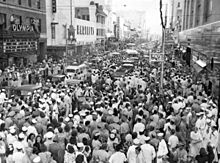 Flagler Street on August 15, 1945, 20 minutes after the announcement of Japan's surrender at the end of World War II.
Flagler Street on August 15, 1945, 20 minutes after the announcement of Japan's surrender at the end of World War II.
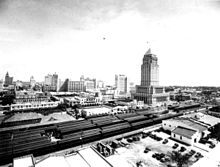 Downtown skyline circa 1930s, with the Florida East Coast Railway passenger train station and the Dade County Courthouse in the foreground
Downtown skyline circa 1930s, with the Florida East Coast Railway passenger train station and the Dade County Courthouse in the foreground
Downtown Miami is the historic heart of Miami, and along with Coconut Grove, is the oldest settled area of Miami, with early pioneer settlement dating to the early 19th century. Urban development began in the 1890s with the construction of the Florida East Coast Railway by Standard Oil industrialist Henry Flagler down to Miami at the insistence of Julia Tuttle. Flagler, along with developers such as William Brickell and George E. Merrick helped bring developer interest to the city with the construction of hotels, resorts, homes, and the extension of Flagler's rail line. Flagler Street, originating in Downtown, is a major east-west road in Miami named after the tycoon; the Julia Tuttle Causeway, crossing Biscayne Bay just north of Downtown in Edgewater, is named in honor of Tuttle.
Neighborhoods
Downtown Miami is centered on the Central business district (CBD), best known by local Miamians as simply "Downtown". Although distinct neighborhoods with different characters, the following neighborhoods are often labeled under the umbrella term of "Downtown Miami":
Central business district ("Downtown")
The Central business district (CBD), better known by locals as simply just "Downtown", is the historic center of Miami, and what is traditionally called "Downtown". Downtown is bound by NE 6th St to the north, Biscayne Bay to the east, the Miami River to the west and south. Within this area, is where the majority of Miami's historic buildings are, the main shopping street, Flagler Street, museums, libraries, offices, schools and colleges, as well as the vast majority of local, county, state and federal government offices and courthouses.
Downtown is directly served by the Miami Metrorail at: Government Center Station, and by 13 Metromover stations on the Downtown, Brickell, and Omni Loops.
Brickell
Brickell is south of the Miami River, and is a mixed upper-class residential neighborhood as well as Miami's major financial district along Brickell Avenue. The Shops at Mary Brickell Village and Simpson Park are located within Brickell. Brickell is directly served by the Miami Metrorail at: Brickell Station, and by 5 Metromover stations on the Brickell Loop.
Omni
Omni is an urban neighborhood with numerous hotels, and high-rise residential buildings. The neighborhood's name comes from the Omni International Mall on Biscayne Boulevard. Omni borders Biscayne Bay the east, NE 2nd Ave to the west, NE 21st St to the north and I-395 to the south. Pace Park, Adrienne Arsht Center for the Performing Arts, and the Miami Herald headquarters are located within Omni. Omni is served by the Miami Metrorail at: Government Center Station, and by 2 Metromover stations on the Omni Loop.
Park West
Park West is the neighborhood just west of Bicentennial Park, east of NW 1st Ave, south of I-195, and north of NE 6th St. Park West is primarily known for its nightclubs, and in recent years has been the talk of much revitalization and project proposals for the revitalization of the area. Park West is directly served by the Miami Metrorail at: Historic Overtown/Lyric Theatre Station, and by 3 Metromover stations on the Omni Loop.
Miami Jewelry District
The Miami Jewelry District is a sub-neighborhood of Downtown within the Central Business District historically known for its numerous jewelry stores, jewelers and gem dealers. It is where a variety of jeweled products are sold and is one of the three jewelry districts in the United States.[5] It comprises four city blocks, bounded by North Miami Avenue, NE 2nd Avenue, East Flagler Street and NE 2nd St. Shoppers can find designer jewelry, precious stones, and gold and silver items at street level in various retail jewelry stores. The Jewelry District can be accessed by public transportation through the Metromover and Metrorail.
Demographics
Historical populations Census Pop. %± 1990 36,140 — 2000 39,176 8.4% 2010 71,000 81.2% source:[6] 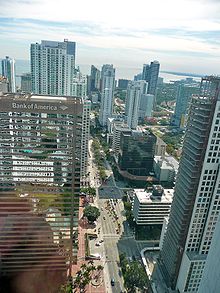 An aerial view of Brickell, the neighborhood south of the Miami River looking down Brickell Avenue. Brickell is the fastest-growing neighborhood in Miami, and has one of the highest population densities outside of New York City[7]
An aerial view of Brickell, the neighborhood south of the Miami River looking down Brickell Avenue. Brickell is the fastest-growing neighborhood in Miami, and has one of the highest population densities outside of New York City[7]
As of 2010, the population of Downtown Miami was 71,000 people, with a population density of 27,487 per square mile. In the 2010 US Census, the racial makeup of Downtown was 57.6% Hispanic of any race, 30.8% White (non-Hispanic), 7.2% Black, and 2.9% Asian.[8] The zip codes for Brickell include 33129, 33130, and 33131. The area covers 1.084 square miles (2.81 km2).
In 2000, Downtown had a population of 39,176 residents, with 15,333 households in 1990 with an average of 2.2 residents per household, 17,130 households in 2000 with a household average of 2.1, and 33,600 households in 2009 with a household average of 2.0 residents. By 2014, the population of Downtown is expected to grow to 85,000 with 42,400 households. The median household income was $29,396 in 2000 and $40,180 in 2009.[9]
The zip codes for Downtown include 33128, 33130, 33131, and 33132. The area covers 2.117 square miles (5.48 km2). As of 2000, there were 6,451 males and 4,792 females. The median age for males were 34.5 years old, while the median age for females were 35.8 years old. The average household size had 1.9 people, while the average family size had 2.8 members. The percentage of married-couple families (among all households) was 25.5%, while the percentage of married-couple families with children (among all households) was 8.5%, and the percentage of single-mother households (among all households) was 5.8%. 15.3% of the population was in correctional institutions. 1.6% of the population was in other group homes. The percentage of never-married males 15 years old and over was 27.6%, while the percentage of never-married females 15 years old and over was 13.9%.[10]
As of 2000, the percentage of people that speak English not well or not at all made up 23.1% of the population. The percentage of residents born in Florida was 26.9%, the percentage of people born in another U.S. state was 25.0%, and the percentage of native residents but born outside the U.S. was 6.4%, while the percentage of foreign born residents was 41.7%.[10]
2009 Census projections indicate that the area’s residential base has increased from 40,000 to 71,000 since 2000, with an expected Downtown population of 85,000 by 2014. As of 2006, 189,164 residents live in the immediate Downtown/Brickell area.[2][3]
Transportation
See also: Transportation in Miami A Metrorail train approaching Government Center. Public transportation is a vital part of Downtown life
A Metrorail train approaching Government Center. Public transportation is a vital part of Downtown life
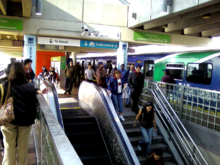 Government Center is the main station in Downtown, and the busiest station in the entire Metro system. Government Center is served by Metrorail, Metromover, and Metrobus
Government Center is the main station in Downtown, and the busiest station in the entire Metro system. Government Center is served by Metrorail, Metromover, and Metrobus
 The Metromover is free and has three loops throughout Downtown, Brickell, and Omni. There are Metromover stations at roughly every two blocks in the area
The Metromover is free and has three loops throughout Downtown, Brickell, and Omni. There are Metromover stations at roughly every two blocks in the area
Public transportation in the Downtown area is used more than in any other part of Miami and is a vital part of Downtown life. Metrorail, Miami's heavy rail system, makes 3 stops in Downtown at the Historic Overtown/Lyric Theatre Station, Government Center Station, and the Brickell Station. In addition to Metrorail, the Metromover train system runs 3 lines (the Downtown Loop, the Omni Loop, and the Brickell Loop) with 22 stations throughout Downtown. The Metromover is free and stations can be found at roughly every two blocks in Downtown and Brickell.
Downtown Miami is served by Metrobus throughout the area, the Miami Metrorail, and the Metromover:
Metrorail:
- Government Center (NW 1st Street and NW 1st Avenue)
- Brickell (SW 11th Street and SW 1st Avenue)
- Historic Overtown/Lyric Theatre (NW 8th Street and NW 1st Avenue)
Metromover:
- Downtown/Inner Loop
- Omni Loop
- Brickell Loop
Metrorail has stops throughout Miami with connections to Miami International Airport, all Metrobus lines, Tri-Rail and Amtrak. The main bus station in Downtown is located next to the Arsht Center at the Adrienne Arsht Center Station.
As an urban and pedestrian-friendly area with an extensive public transit network, Downtown (along with Brickell, Omni, and South Beach) is one of the areas in Miami where a car-free lifestyle is commonplace. Many Downtown residents get around by foot, bicycle, Metromover or by taxi. The Metromover is a popular alternative to walking in the area, especially on rainy, hot or cold days, as the Metromover is free, and stations are located roughly every two blocks throughout the area.
Recently, the City of Miami, along with the Downtown Development Authority, has begun bicycle initiaves promoting city-wide bike parking and bike lanes, that have made bicycling much more popular for residents. Bike lanes and bike sharrows are currently planned for the majority of Downtown streets to be painted by the end of 2010. The Venetian Causeway is a popular bicycle commuter route that connects South Beach to Downtown. The Rickenbacker Causeway is very popular on weekends for recreational bicyclists, and oftentimes, bicycles can outnumber cars on the causeway.[11]
Tri-Rail expansion
In the 2025 and 2030 long range transportation plans, Miami's commuter rail system, Tri-Rail, has envisioned moving to or adding service on the Florida East Coast Railway (FEC) corridor, which runs along the region's densest neighborhoods, parallel to Biscayne Boulevard in Miami, and Federal Highway in Broward and Palm Beach counties.
Tri-Rail service on the FEC line would bring Tri-Rail to Downtown's transit hub, Government Center Station, connecting Downtown directly to Midtown Miami/Miami Design District, Upper East Side/Miami Shores, North Miami, North Miami Beach/Aventura, Downtown Hollywood, and Downtown Fort Lauderdale. Currently, rail commuters must transfer onto the Metrorail in Hialeah to get to Downtown. Miami's Downtown Development Authority along with Miami-area politicians are actively lobbying to bring Tri-Rail to the city core.[12]
Taxis
Taxis are popular in Downtown, especially from Downtown to South Beach, Design District or to Coconut Grove. Since many Downtown residents choose to not have cars, taxis are also popular for rides within Downtown neighborhoods, especially after midnight when the Metromover stops running. Taxis can be hailed on the street, or phoned. For a list of taxi stands in Downtown, Park West, Omni, and Brickell see: Downtown Miami Taxi Stands
Economy
Downtown is South Florida's main hub for finance, commerce and international business. Brickell Avenue has the largest concentration of international banks in the U.S.
Downtown is home to many companies, corporations and organizations. Downtown has about 20,000,000 square feet (1,900,000 m2) of office space, and is the central financial and business hub of South Florida.[1] Some private companies with headquarters in Downtown are Akerman Senterfitt, Arquitectonica, Bilzin Sumberg, Espírito Santo Financial Group, Florida Justice Institute, Greenberg Traurig, Holland & Knight, Limehouse Software, Macy's Florida, Miami Herald, Miami Today, Shutts & Bowen, Terremark Worldwide, Vector Group, World Property Channel, and Zyscovich Architects.[13] Sanford Group Company and Sanford Fiduciary Investor Services, Inc., and LTU International had headquarters in Downtown.[14][15]
Public organizations with their main offices in Downtown include, the central offices of the Beacon Council, the Downtown Development Authority, Miami-Dade County government, Miami-Dade County Public Schools, Miami Police Department, and Miami-Dade Parks and Recreation, as well as numerous City of Miami departments despite city hall's location in Coconut Grove.
Consulates
Several countries have consulates based in Downtown, most of which are located along Biscayne Boulevard and Brickell Avenue. These include:
- Argentina[16]
- Bahamas[17]
- Brazil[18]
- Chile[19]
- Dominican Republic[20]
- Ecuador[21]
- France[22]
- Germany[23]
- Guatemala[24]
- Haiti[25]
- Israel(Consulate-General of Israel to Florida & Puerto Rico)[26]
- Jamaica[27]
- Japan[28]
- Netherlands[29]
- Paraguay,[30]
- Peru[31]
- Trinidad and Tobago[32]
- United Kingdom[33]
- Venezuela[34]
Chambers of commerce
Downtown is also home to many international chambers of commerce, these include:
- British American Business Council
- Italy-America Chamber of Commerce
- Spain-United States Chamber of Commerce
- German American Business Chamber
- Chilean-American Chamber of Commerce
- French American Chamber of Commerce.
Historic districts
 The Downtown Miami Historic District has over 60 buildings ranging from 1896-1939 in the heart of Downtown
The Downtown Miami Historic District has over 60 buildings ranging from 1896-1939 in the heart of DowntownLocation: Downtown, Miami, Florida Coordinates: 25°46′27″N 80°11′37″W / 25.77417°N 80.19361°WCoordinates: 25°46′27″N 80°11′37″W / 25.77417°N 80.19361°W Area: 380 acres (1,500,000 m2) NRHP Reference#: 05001356 and 88003057 Added to NRHP: 1988 and 2005 Downtown has three U.S. historic districts. The Downtown Miami Commercial Historic District, the Downtown Miami Historic District, and the Lummus Park Historic District.[35]
The Downtown Miami Historic District comprises 380 acres (1.5 km2) in the heart of Downtown with over 60 buildings within its jurisdiction. Many of the buildings within the area are of the Moderne style and Classical Revival style with uses for government, residential, and commercial. Periods of significance within this area are from 1900–1924, 1925–1949, and 1950-1974. The Downtown Miami Commercial Historic District was designated a historic district in 1988 and comprises 20 buildings on the east side of Downtown with 19th and early 20th-century revival styles.
The Lummus Park Historic District is west of Downtown in the neighborhood of Lummus Park. It is west of I-95 surrounding Lummus Park along the Miami River. The historic district was designated historic in 1988 and then expanded in 2006. The area is 260 acres (1.1 km2) large with 43 different buildings mostly owned by private entities and the local government. Prominent styles include late 19th and early 20th-century revival styles, Art Deco, and Bungalow style, with prominent periods of 1900-1924 and 1925-1949.
Parks
Downtown's largest and most popular parks are Bayfront Park, Bicentennial Park, and Pace Park. Bayfront Park is host to the free DWTWN Concert Series, put on weekly in the park's amphitheater, as well as various other annual events such as the Orange Drop for New Year's, Bike Miami, and the "America's Birthday Bash at Bayfront Park" for Independence Day. Bicentennial Park hosts many large outdoor concerts such as Warped Tour and Ultra Music Festival. Bicentennial Park is currently planned to be redone, and is to include the new buildings for the Miami Art Museum and the Miami Science Museum.
Other parks in the Downtown area include:
- Fort Dallas Park, CBD
- Lummus Park, CBD
- Paul S. Walker Park, CBD
- Joan Lehman Sculpture Plaza, CBD
- Robert F. Clark Plaza, CBD
- Southside Park, Brickell
- Simpson Park, Brickell
- Alice Wainwright Park, Brickell
- Brickell Park, Brickell
- Miami Circle, Brickell
- Brickell Key Park, Brickell
- Brickell Plaza Mini Park, Brickell
Government and infrastructure
 The Miami-Dade County Courthouse built in 1925, is one of many local, state and federal courthouses in Downtown, centered primarily around Government Center.
The Miami-Dade County Courthouse built in 1925, is one of many local, state and federal courthouses in Downtown, centered primarily around Government Center.
As the county seat of Miami-Dade County, Downtown is home to the central offices and departments of the Miami-Dade County government. The Stephen P. Clark Government Center is the central headquarters of Miami-Dade government with the offices of the Miami-Dade Mayor. Although city hall for the City of Miami is in Coconut Grove, many offices of Miami's city government are in Downtown, including the city's Planning Department. The Miami Police Department also has its central offices in Downtown.[36]
Downtown is home to many city, county, state, and federal courthouses, jails, judge offices, and law firms. Some of the courthouses in Downtown are the Dade County Family Court, U.S. Court of Appeals Judge, U.S. District Court Clerk,[37] Miami-Dade County Courthouse,[38] Federal Courthouse, U.S. Magistrate Judge, City of Miami courthouses and many others.[39]
The United States Postal Service operates two post offices in Downtown. They are the Brickell Post Office and the Flagler Miami Post Office.[40][41] The Federal Detention Center, Miami, operated by the Federal Bureau of Prisons, is located in Downtown.[42]
Fire stations
The City of Miami Fire and Rescue Department operates 4 of its 14 Fire Stations within the Downtown area. Each are listed below.
- Fire Station # 1 - 144 NE 5th Street - Midtown/Overtown (Downtown)
- Fire Station # 2 - 1901 N Miami Avenue - Wynwood/Edgewater
- Fire Station # 3 - 1103 NW 7th Street - Little Havana/Overtown
- Fire Station # 4 - 1105 SW 2nd Avenue - Brickell/The Roads (Downtown)
Hotels
Downtown has over 6,000 hotel rooms in numerous hotels. Downtown has Miami's largest concentration of hotel rooms, and is the city's hub for business travellers. Many of these hotels are geared for business travellers, mostly along Brickell Avenue, some for luxury leisure stays, and others as bargain tourist hotels. Some of Downtown's largest hotels are:[1]
Central business district
- Continental Bayside Hotel, 146 Biscayne Blvd
- Courtyard Marriott, 200 SE 2nd Av
- Epic Hotel, 270 Biscayne Blvd Way
- Holiday Inn, 340 Biscayne Blvd
- Hotel Beaux Arts Miami, 255 Biscayne Blvd Way
- InterContinental Hotel, 100 Chopin Plaza
- JW Marriot Marquis Miami, 345 SE 2nd Av
- River Park Hotel & Suites, 100 SE 4th St
Brickell
- Conrad Miami, 1395 Brickell Av
- The Four Ambassadors Hotel, 801 Brickell Bay Dr
- Four Seasons Hotel Miami, 1435 Brickell Av
- Hotel Urbano, 2500 Brickell Av
- JW Marriott Hotel Miami, 1109 Brickell Av
- Mandarin Oriental, 500 Brickell Key Dr
- Viceroy Miami, 485 Brickell Av
- Hampton Inn Brickell, 50 SW 12th St
- Aloft Brickell, 1001 SW 2nd Av
Omni & Park West
- DoubleTree Grand Hotel, 1717 N Bayshore Dr
- Hilton Downtown Miami, 1601 Biscayne Blvd
- Marriott Biscayne Bay, 1633 N Bayshore Dr
- Tempo, 1100 Biscayne Blvd
Cost of living
The average apartment sale price was $347,729 in 2010, up 15% from 2009, with the average apartment price at $300 per square foot. During the Miami building boom of the mid-first decade of the 21st century, 23,628 condominium and apartments were built in numerous high-rise towers that quickly transformed the city. Over 85% of these apartments are now occupied as of early 2011. It is estimated that about 550 new residents move to Downtown every month.[43] Renters make up 56% of the residents in Downtown.[44]
In July 2011, Downtown's office vacancy rate was reported at 21% dropping from a high of 26% in mid-2010. Downtown also reported an average commercial asking rate of $36.33, making it the eighth-highest in the nation after Manhattan, Washington DC, Fairfield County, Connecticut, San Francisco, and Boston.[45]
Retail
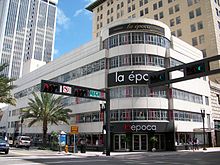 La Época, a local Miami store, is one of the main department stores on Flagler Street. Flagler Street has been Downtown's main shopping street since the 1800s
La Época, a local Miami store, is one of the main department stores on Flagler Street. Flagler Street has been Downtown's main shopping street since the 1800s
Historically, Flagler Street has been Downtown's major shopping street dating back to the 19th century. Today, it is still Downtown's major shopping street, with Florida's flagship Macy's (formerly Burdines) on Flagler Street and Miami Avenue since 1912, as well as Miami's own local department stores: La Época, on Flagler and SE 2nd Av; and Alberto Cortes, on Flagler and SE 3rd Av. Flagler Street is also home to many well-known and established jewelers, many of whom have been in Downtown since the early 20th century (i.e.: Morays Jewelers, founded in 1900). This area is called the Miami Jewelry District and comprises four Downtown blocks from Miami Avenue to SE 2nd Av on Flagler Street and NE 1st St.
After many years of decay, recently, much focus has been placed on revitalizing Flagler Street to its former grandeur. In recent years, a renewed investment interest has been placed on Flagler Street, and many new restaurants and stores have opened up, new landscaping and pavers have been placed, as well as enforced security and tourist guides. Three new pocket parks opened on Flagler St in 2009, Paul S. Walker Park, Robert F. Clark Plaza, and the Joan Lehman Sculpture Plaza. These new parks have brought more green space, benches, art, and rest areas to the street.
Besides Flagler Street, Downtown has two other major shopping areas, Bayside Marketplace and Mary Brickell Village in Brickell. Bayside Marketplace was built in 1987, and is one of Miami's most visited tourist attractions averaging over 15 million visitors a year. It is an outdoor shopping mall overlooking Biscayne Bay at Bayfront Park. Bayside Marketplace has many national retail chains, as well as local Miami stores. Mary Brickell Village is on Miami Avenue and SE 10th Street in Brickell. Mary Brickell Village is a major nightlife area and has many of Miami's upscale bars and restaurants that stretch along Miami Avenue from around SE 6th Street to Broadway (SE 15th Road).
Education
Public schools
 Adrienne Arsht Center for the Performing Arts, the second-largest performing arts center in the U.S.
Adrienne Arsht Center for the Performing Arts, the second-largest performing arts center in the U.S.
Miami-Dade County Public Schools operates area public schools:
Elementary schools
- Downtown Miami Charter School
- Southside Elementary School
- Ada Merritt K-8 School
- Frederick R Douglass Elementary School
- Riverside Elementary School
- Miami Children's Museum School
- Bridgepoint Academy of Greater Miami (Charter)
High schools
- Booker T. Washington High School
- Law Enforcement Officers Memorial High School, magnet school
- Young Women's Preparatory Academy, all-girls
- New World School of the Arts, arts magnet school
Public school zoning
Downtown children are zoned based on the neighborhood they live in within Downtown, roughly split into Brickell, Central Business District (CBD), and Omni/Edgewater.[47]
- Elementary schools:
- Southside Elementary School, for Brickell children
- Riverside Elementary School, for CBD children
- Frederick Douglass Elementary School, for CBD children
- Phillis Wheatley Elementary School, for Omni and Edgewater children
- Middle schools:
- Shenandoah Middle School, for Brickell children
- José de Diego Middle School, for CBD, Omni and Edgewater children
- High schools (open to all Downtown residents):
- Young Women's Preparatory School, all-girls
- Young Men's Preparatory School, all-boys
- Booker T. Washington High School
Private schools
Plans are currently underway for a 1,700-student preparatory school in Brickell at 1742 SW 2nd Avenue, named "Brickell Preparatory Academy". Other private schools in Downtown are:
- First Presbyterian International Christian School
- Gordon Day School (Jewish)
- Prima Casa Montessori School
Colleges and universities
- Miami Dade College (Wolfson Campus) - public college
- Florida International University (Downtown Campus) - public university, 1101 Brickell Avenue
- Miami International University of Art & Design - private college
- Miami Culinary Institute- public college
Cultural institutions
 Miami Art Museum. A new home for the MAM along with the Miami Science Museum are currently under construction in the new Museum Park in Downtown's Park West neighborhood
Miami Art Museum. A new home for the MAM along with the Miami Science Museum are currently under construction in the new Museum Park in Downtown's Park West neighborhood
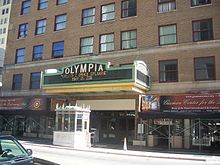 Gusman Center for the Performing Arts is one of the last remaining theaters from the many that once existed on Flagler Street in the 1920s
Gusman Center for the Performing Arts is one of the last remaining theaters from the many that once existed on Flagler Street in the 1920s
 Gesu Church, built in 1896, is the oldest Catholic church in Miami, and one of many central churches and synagogues in Downtown
Gesu Church, built in 1896, is the oldest Catholic church in Miami, and one of many central churches and synagogues in Downtown
Museums and historic sites
- Miami Art Museum
- Historical Museum of Southern Florida
- Miami Children's Museum
- Wagner Home
- Freedom Tower
- City of Miami Cemetery
- Downtown Miami Historic District
- Lummus Park Historic District
- Miami Circle
Theatres and performance arts
- Adrienne Arsht Center for the Performing Arts
- Ziff Ballet Opera House
- Knight Concert Hall
- Florida Grand Opera
- Gusman Center for the Performing Arts
- Miami City Ballet
- Miami Wind Symphony
Libraries
Places of worship
- Central Baptist Church (Built in 1925)
- First Church of Christ Scientist- Miami (1925)
- First Presbyterian Church (1898)
- First United Methodist Church (1966)
- Gesu Catholic Church (1896)
- Greater Bethel AME Church (1927)
- St. Jude Catholic Church (1946)
- Temple Israel of Greater Miami (1926)
- Trinity Episcopal Cathedral (1925)
- Immanuel Lutheran Church
- Central Korean Presbyterian Church
- The Shul of Downtown and Brickell
Bookstores
- Downtown Book Center, Inc. - 247 SE 1st St
- Books and Books - Wachovia Financial Center
- Miami Book Fair International, an annual literary festival held at Miami Dade College
Festivals and events
- DWNTWN Concert Series, free performances every 2nd Friday of the month at 5:30pm, Bayfront Park
- New Year's Big Orange Drop, Bayfront Park
- Miami Marathon, marathon held in January
- Ultra Music Festival, electronic music festival held in March
- Miami International Film Festival, held in March
- Winter Music Conference, held in March
- Independence Day Celebration, Bayfront Park
- Miami Book Fair International, literary festival held in November
- Art Basel Miami, art exhibition held in December
- Miami International Boat Show
- The Arts Of Storytelling, held in March
Sports facilities
- American Airlines Arena, home of the Miami Heat
- Miami Ballpark, future home of the Florida Marlins
Downtown skyscrapers
- Hotel towers
- Residential towers
- 900 Biscayne Bay
- Ten Museum Park
- 1800 Club
- Wind
- Marinablue
- One Miami East Tower
- One Miami West Tower
- Opera Tower
- Quantum on the Bay North Tower
- Quantum on the Bay South Tower
- The Ivy
- Marquis Miami
- Mint
- 50 Biscayne
- Met 1
- The Loft 2
- Everglades on the Bay North Tower
- Everglades on the Bay South Tower
- Office towers
- Four Seasons Hotel and Tower
- Southeast Financial Center
- Miami Tower
- One Biscayne Tower
- 1450 Brickell
- 701 Brickell Avenue
- Brickell Financial Centre
- Espirito Santo Plaza
- Sabadell Financial Center
- Brickell Bay Office Tower
- Latitude One
- SunTrust International Center
- Alfred I. DuPont Building
- Miami Center
- Courthouse Center
- Museum Tower
- Dade County Courthouse
- New World Tower
- Stephen P. Clark Government Center
- Met 2 (Wells Fargo Center)
Gallery
-
Miami Tower lit in neon pink
-
Marquis Miami on the Biscayne Wall
-
Statue of Julia Tuttle in Bayfront Park
-
Fort Dallas, built in 1836, military base from the Seminole Wars, circa 1930s
-
Brickell and the mouth of the Miami River in 1935. Current location of the Miami Circle Park and Icon Brickell
-
Downtown after the 1926 Miami Hurricane
-
Miami Dade College's Wolfson Campus in 1970
See also
References
- ^ a b c http://miamidda.com/main_about.asp
- ^ a b c http://www.cpnfromtheinside.com/2009/07/study-confirms-downtown-miami-is-coming-to-life.html
- ^ a b http://www.miamidda.com/business-demographics.html
- ^ http://www.miamiherald.com/103/story/1030124.html
- ^ Biscayne Boulevard Improvements
- ^ "Population and Demographics Profile". Miami DDA. http://miamidda.com/pdf/Population_and_Demographic_Profile_Nov2009.pdf. Retrieved 2011-07-15.
- ^ http://projects.nytimes.com/census/2010/map
- ^ Mapping the 2010 U.S. Census - NYTimes.com
- ^ http://miamidda.com/pdf/Population_and_Demographic_Profile_Nov2009.pdf
- ^ a b "Demographics of Downtown, Miami, FL.". city-data. http://www.city-data.com/neighborhood/Downtown-Miami-FL.html. Retrieved 2009-08-31.
- ^ Do bicyclists and pedestrians outnumber cars on the Rickenbacker Causeway on weekend mornings? | Transit Miami
- ^ Miami Downtown Development Authority hashing out plans to bring Tri-Rail downtown
- ^ Vector Group Ltd
- ^ "Contact Us." LTU International. March 3, 2000. Retrieved on June 21, 2009.
- ^ "Company Directory." Stanford Financial Group. July 8, 2000. Retrieved on June 21, 2009.
- ^ "Contactenos." Consulate-General of Argentina in Miami. Retrieved on January 30, 2009.
- ^ "Contact & Overseas Missions." Ministry of Foreign Affairs (The Bahamas). Retrieved on January 31, 2009.
- ^ "The Consulate."Consulate-General of Brazil in Miami. Retrieved on January 30, 2009.
- ^ "Oficinas Consulares en Estados Unidos."
- ^ "Welcome to the website of the Consulate General of the Dominican Republic in Miami.", Consulate-General of the Dominican Republic in Miami. Retrieved on January 31, 2009.
- ^ "Other Consulates in the USA.", Embassy of Ecuador in Washington, DC. Retrieved on January 30, 2009.
- ^ "Address.", Consulate-General of France in Miami. Retrieved on January 30, 2009.
- ^ "Address, Contact and Office Hours.", Consulate-General of Germany in Miami. Retrieved on January 30, 2009.
- ^ "Consular Offices.", Consulate-General of Guatemala in Denver. Retrieved on January 31, 2009.
- ^ "Diplomatic and Consular Missions.", Embassy of Haiti in Washington, DC. Retrieved on January 30, 2009.
- ^ "Consulate-General of Israel to Florida & Puerto Rico.", Israel Diplomatic Network. Retrieved on January 30, 2009.
- ^ "Contact.", Consulate-General of Jamaica in Miami. Retrieved on January 30, 2009.
- ^ "Contact.", Consulate-General of Japan in Miami. Retrieved on January 30, 2009.
- ^ Home page., Consulate-General of Netherlands in Miami. Retrieved on January 30, 2009.
- ^ "El Consulado Retrieved on January 30, 2009.
- ^ "Datos Generales
- ^ "Consulate General of the Republic of Trinidad and Tobago Miami." Retrieved on May 18, 2011
- ^ "Miami." UK in USA. Retrieved on January 30, 2009.
- ^ "Información General. Retrieved on January 30, 2009.
- ^ National Register of Historical Places - FLORIDA (FL), Dade County
- ^ http://www.miami-police.org/index.asp
- ^ http://www.miami-dadeclerk.com/
- ^ "Dade County Courthouse Map." Miami-Dade County. Retrieved on March 12, 2010.
- ^ http://www.usmarshals.gov/district/fl-s/locations/index.html
- ^ "Post Office Location - BRICKELL." U.S. Postal Service. Retrieved on December 30, 2009.
- ^ "Post Office Location - FLAGLER MIAMI." U.S. Postal Service. Retrieved on December 30, 2009.
- ^ "FDC Miami Contact Information." Federal Bureau of Prisons. Retrieved on December 30, 2009.
- ^ http://miamidda.com/pdf/DDA_Feb2011_OccupancyStudyRelease.pdf
- ^ House Keys | Sun Sentinel Blogs | A major revival for downtown Miami condos
- ^ http://www.worldpropertychannel.com/us-markets/commercial-real-estate-1/2011-us-office-market-report-cushman-and-wakefield-cbd-office-rates-office-space-for-lease-miami-office-space-for-lease-occupancy-rates-manhattan-office-space-for-lease-4518.php
- ^ http://miami.travelape.com/attractions/freedom-tower/
- ^ Services Near You
External links
- Miami Downtown Development Authority
- Official website
- City of Miami official website
- Miami Downtown Life
- Transit Miami
- Miami EXP
- Miami Photos
Neighborhoods of Miami Allapattah · Brickell (Key) · Buena Vista · Civic Center · Coconut Grove · Coral Way · Design District · Downtown · Edgewater · Flagami · Grapeland Heights · Liberty City · Little Haiti · Little Havana · Lummus Park · Midtown · Omni · Overtown · Park West · The Roads · Upper Eastside · Venetian Islands · Virginia Key · Watson Island · West Flagler · Wynwood

City of Miami Accent • Arts • Climate • Companies • Downtown • Education • Fire • Government • Historic Landmarks • History • Library • Mayors • Miamians • Music • Neighborhoods • Police • Skyscrapers • Sports • Television • Transportation
Municipalities and communities of Miami-Dade County, Florida Cities Aventura | Coral Gables | Doral | Florida City | Hialeah | Hialeah Gardens | Homestead | Islandia | Miami | Miami Beach | Miami Gardens | Miami Springs | North Bay Village | North Miami | North Miami Beach | Opa-locka | South Miami | Sunny Isles Beach | Sweetwater | West Miami
Towns Villages CDPs Brownsville | Coral Terrace | Country Club | Country Walk | Fisher Island | Fountainbleau | Gladeview | Glenvar Heights | Golden Glades | Goulds | Homestead Base | Ives Estates | Kendale Lakes | Kendall | Kendall West | Leisure City | Naranja | Ojus | Olympia Heights | Palm Springs North | Palmetto Estates | Pinewood | Princeton | Richmond Heights | Richmond West | South Miami Heights | Sunset | Tamiami | The Crossings | The Hammocks | Three Lakes | University Park | West Little River | West Perrine | Westchester | Westview | Westwood Lakes
Former CDPs Cutler Bay: Lakes by the Bay
Miami Gardens: Andover | Bunche Park | Carol City | Lake Lucerne | Norland | Opa-locka North | Scott Lake
Palmetto Bay: Cutler | East PerrineUnincorporated
communitiesAladdin City | Biscayne Gardens | Coopertown | Coral Way Village | Deering Bay | Fairlawn | Fortymile Bend | Frog City | Glenwood Heights | Green-Mar Acres | Hawley Heights | Highland Lakes | Howard | Ludlam | Redland | Silver Palm | West Kendall
South Florida metropolitan area Largest city Counties
(by population)Cities and towns
100k-250kCities and towns
25k-99kAventura • Boca Raton • Boynton Beach • Coconut Creek • Cooper City • Coral Gables • Dania Beach • Davie • Deerfield Beach • Delray Beach • Doral • Greenacres • Hallandale Beach • Homestead • Jupiter • Lake Worth • Lauderdale Lakes • Lauderhill • Margate • Miami Beach • North Lauderdale • North Miami • North Miami Beach • Oakland Park • Palm Beach Gardens • Plantation • Riviera Beach • Sunrise • Tamarac • West Park • Weston • Wilton ManorsCities and towns
10k-25k State of Florida
State of FloridaTopics - Delegations
- Environment
- Floridians
- Geography
- Government
- History
- State Parks
- Transportation
- Visitor Attractions
Society - Culture
- Crime
- Demographics
- Economy
- Education
- Politics
Regions Metro areas - Miami–Fort Lauderdale–Pompano Beach (Miami-Dade, Broward, Palm Beach)
- Tampa-St. Petersburg-Clearwater (Hernando, Hillsborough, Pasco, Pinellas)
- Orlando-Kissimmee-Sanford (Lake, Orange, Osceola, Seminole)
- Jacksonville (Duval, Clay, St. Johns, Nassau, Baker)
- North Port–Bradenton–Sarasota (Manatee, Sarasota)
- Cape Coral-Fort Myers (Lee)
- Lakeland-Winter Haven (Polk)
- Palm Bay-Melbourne-Titusville (Brevard)
- Deltona-Daytona Beach-Ormond Beach (Volusia)
- Pensacola-Ferry Pass-Brent (Escambia, Santa Rosa)
- Port St. Lucie (St. Lucie, Martin)
- Tallahassee (Gadsden, Jefferson, Leon, Wakulla)
- Ocala (Marion)
- Naples-Marco Island (Collier)
- Gainesville (Alachua, Gilchrist)
- Fort Walton Beach-Crestview-Destin (Okaloosa)
- Panama City-Lynn Haven-Panama City Beach (Bay)
- Punta Gorda (Charlotte)
- Sebastian-Vero Beach (Indian River)
- Palm Coast (Flagler)
Largest cities Counties - Alachua
- Baker
- Bay
- Bradford
- Brevard
- Broward
- Calhoun
- Charlotte
- Citrus
- Clay
- Collier
- Columbia
- DeSoto
- Dixie
- Duval
- Escambia
- Flagler
- Franklin
- Gadsden
- Gilchrist
- Glades
- Gulf
- Hamilton
- Hardee
- Hendry
- Hernando
- Highlands
- Hillsborough
- Holmes
- Indian River
- Jackson
- Jefferson
- Lafayette
- Lake
- Lee
- Leon
- Levy
- Liberty
- Madison
- Manatee
- Marion
- Martin
- Miami‑Dade
- Monroe
- Nassau
- Okaloosa
- Okeechobee
- Orange
- Osceola
- Palm Beach
- Pasco
- Pinellas
- Polk
- Putnam
- Santa Rosa
- Sarasota
- Seminole
- St. Johns
- St. Lucie
- Sumter
- Suwannee
- Taylor
- Union
- Volusia
- Wakulla
- Walton
- Washington
Categories:- Historic districts in Florida
- Districts in Miami, Florida
- Neighborhoods in Miami, Florida
- Economy of Miami, Florida
- Central business districts in the United States
Wikimedia Foundation. 2010.


